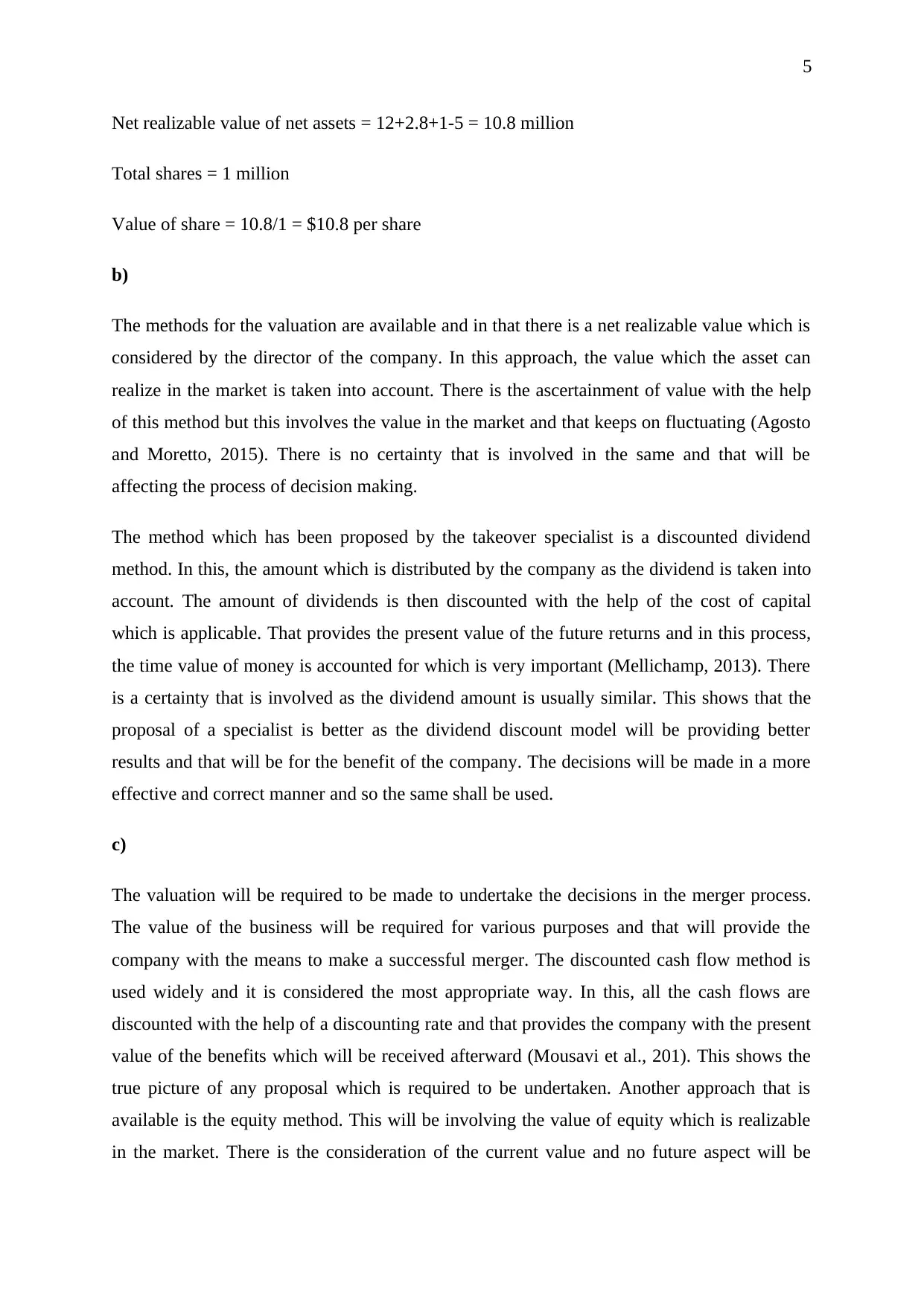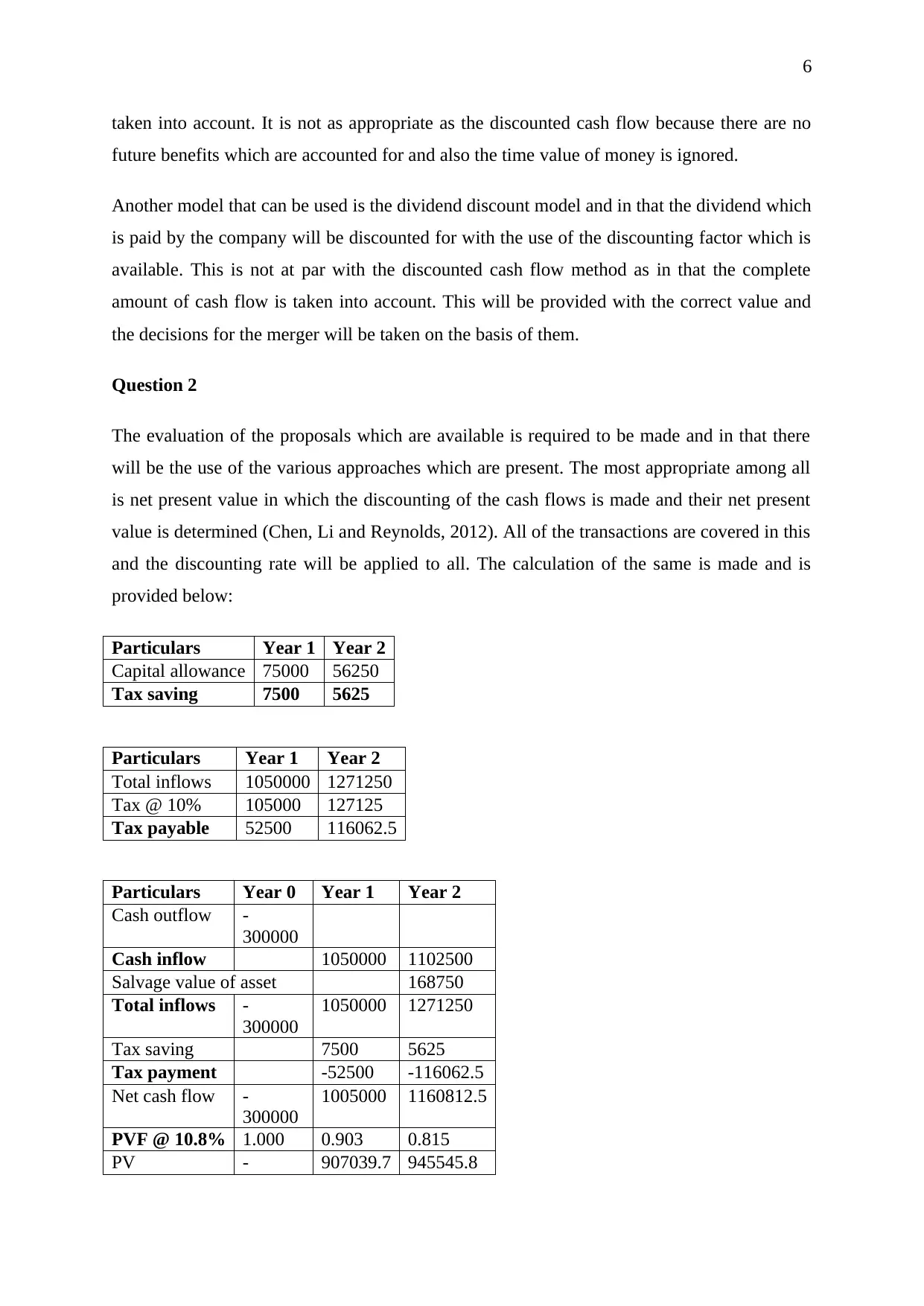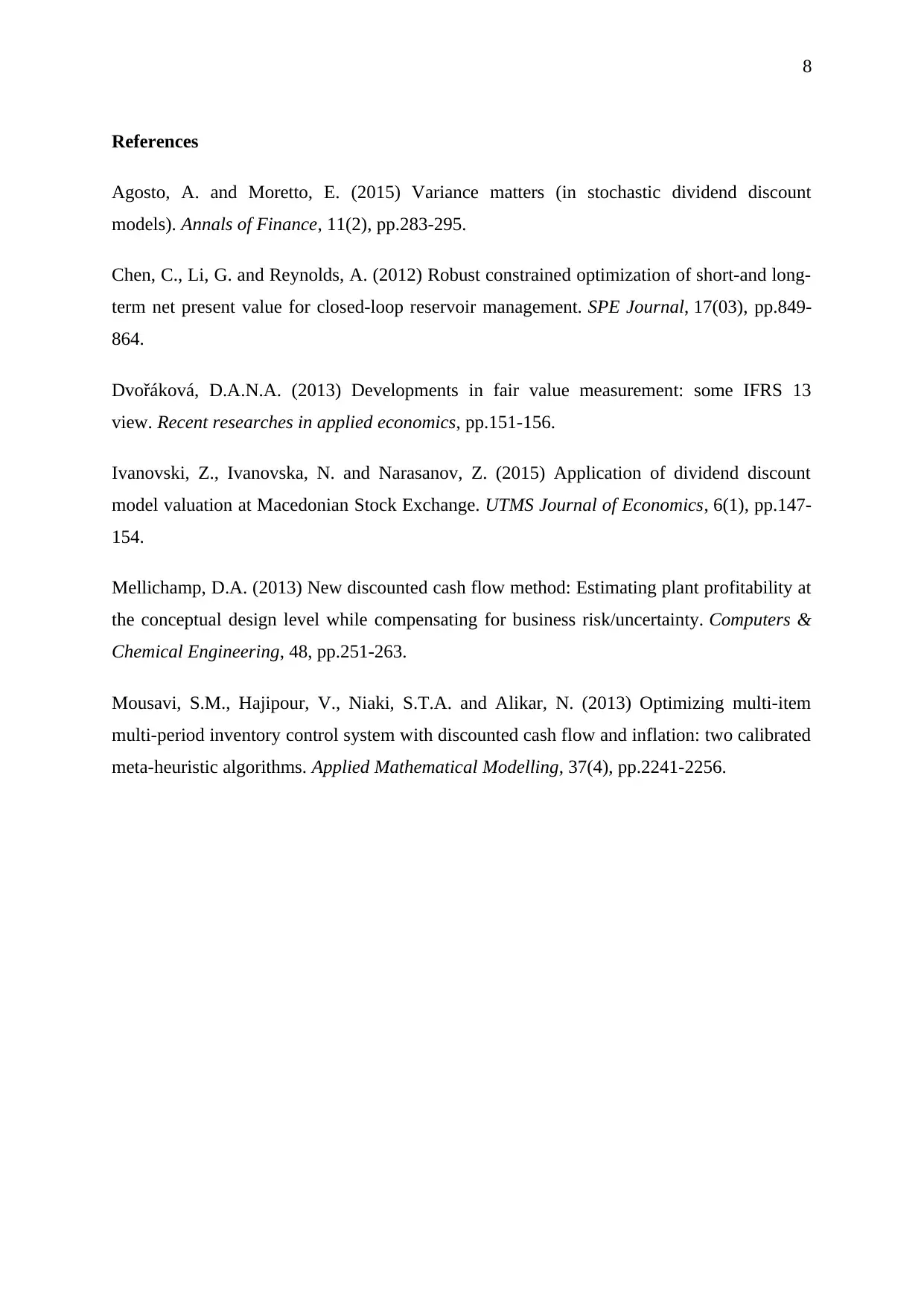Corporate Finance Report: Valuation Techniques and Financial Analysis
VerifiedAdded on 2022/09/07
|8
|1479
|19
Report
AI Summary
This report provides a detailed analysis of corporate finance, focusing on share valuation techniques. It explores three main approaches: the price earning approach, the dividend discount model, and the net realizable value method. The report calculates intrinsic values using provided financial data, including earnings per share (EPS), dividends per share (DPS), and payout ratios. It also examines the advantages of each valuation method, such as discounted cash flow and equity methods, and evaluates the best approach for decision-making in mergers and acquisitions. The report further analyzes project evaluation using the net present value (NPV) method, considering cash inflows, outflows, tax savings, and salvage values. The analysis includes calculations for capital allowances, tax savings, and net cash flows to determine the project's financial viability. The report references several academic sources to support its findings and conclusions.

1
Corporate finance
Corporate finance
Paraphrase This Document
Need a fresh take? Get an instant paraphrase of this document with our AI Paraphraser

2
Table of Contents
Question 1..................................................................................................................................3
a).............................................................................................................................................3
b)............................................................................................................................................5
c).............................................................................................................................................5
Question 2..................................................................................................................................6
References..................................................................................................................................8
Table of Contents
Question 1..................................................................................................................................3
a).............................................................................................................................................3
b)............................................................................................................................................5
c).............................................................................................................................................5
Question 2..................................................................................................................................6
References..................................................................................................................................8

3
Question 1
a)
The valuation of the shares is made and for that, the company is required to make the use of
the most appropriate method. Several of the approaches are available and they can be utilized
in the process of making calculations. The ascertained value will be used in various processes
and for that the calculations are made in an appropriate manner.
Price earning approach: the calculation for the intrinsic value will be made by this and there
will be the use of the PE ratio and the earnings which are made on each share. There is the
need to make use of the formula which is specified.
Particulars 2013 2014 2015 2016
MPS 10 13.2 9 10
DPS 0.1 0.12 0.12 0.13
Pay-out ratio 20% 20% 30% 25%
EPS 0.5 0.6 0.4 0.52
PE 20 22 22.5 19.23077
Average earnings
multiplier
20.93
EPS 5.36
Intrinsic value 20.93 * 5.36
112.2 cents per share
$1.12 per share
P/E = share value / EPS
The EPS in the given case is calculated by dividing the DPS by pay-out ratio.
Dividend discount model:
Dividends are required to be paid by the company and in this method, the discounting of
them is made by considering the cost of capital and growth rate which is made applicable
(Ivanovski, Ivanovska and Narasanov, 2015).
The cost of equity will be calculated by using the CAPM approach which is as follows:
Ke = Rf + b (Rm – Rf)
Ke = 5 + 0.7 (12-5)
Question 1
a)
The valuation of the shares is made and for that, the company is required to make the use of
the most appropriate method. Several of the approaches are available and they can be utilized
in the process of making calculations. The ascertained value will be used in various processes
and for that the calculations are made in an appropriate manner.
Price earning approach: the calculation for the intrinsic value will be made by this and there
will be the use of the PE ratio and the earnings which are made on each share. There is the
need to make use of the formula which is specified.
Particulars 2013 2014 2015 2016
MPS 10 13.2 9 10
DPS 0.1 0.12 0.12 0.13
Pay-out ratio 20% 20% 30% 25%
EPS 0.5 0.6 0.4 0.52
PE 20 22 22.5 19.23077
Average earnings
multiplier
20.93
EPS 5.36
Intrinsic value 20.93 * 5.36
112.2 cents per share
$1.12 per share
P/E = share value / EPS
The EPS in the given case is calculated by dividing the DPS by pay-out ratio.
Dividend discount model:
Dividends are required to be paid by the company and in this method, the discounting of
them is made by considering the cost of capital and growth rate which is made applicable
(Ivanovski, Ivanovska and Narasanov, 2015).
The cost of equity will be calculated by using the CAPM approach which is as follows:
Ke = Rf + b (Rm – Rf)
Ke = 5 + 0.7 (12-5)
⊘ This is a preview!⊘
Do you want full access?
Subscribe today to unlock all pages.

Trusted by 1+ million students worldwide

4
Ke = 9.9%
The value of the share will be calculated by using the formula which is as provided.
P0 = D1 / (Ke – g)
D1 = prospective dividend
D1 = 5.36 * 25%
D1 = 1.34 cents
The growth rate will be calculated by using the average growth of hellcat and the same is
calculated hereunder:
Particulars 2013 2014 2015 2016
DPS 0.1 0.12 0.12 0.13
Growth 0.2 0 0.083333
9.44%
P0 = D1 / (Ke – g)
P0 = 1.34 / (9.9 – 9.44)
P0 = 291.30 cents
Share value = $2.913
Net realizable value approach:
The value which is realizable for the assets in the market is considered under this approach
(Dvořáková, 2013). The calculation of share price will be made with the use of this method in
the following ways.
Realizable value of PPE = 10*1.2 = 12 million
Realizable value of current assets = (2+1+1)*0.7 = 2.8 million
Cash = 1 million
Bonds = 5 million
Ke = 9.9%
The value of the share will be calculated by using the formula which is as provided.
P0 = D1 / (Ke – g)
D1 = prospective dividend
D1 = 5.36 * 25%
D1 = 1.34 cents
The growth rate will be calculated by using the average growth of hellcat and the same is
calculated hereunder:
Particulars 2013 2014 2015 2016
DPS 0.1 0.12 0.12 0.13
Growth 0.2 0 0.083333
9.44%
P0 = D1 / (Ke – g)
P0 = 1.34 / (9.9 – 9.44)
P0 = 291.30 cents
Share value = $2.913
Net realizable value approach:
The value which is realizable for the assets in the market is considered under this approach
(Dvořáková, 2013). The calculation of share price will be made with the use of this method in
the following ways.
Realizable value of PPE = 10*1.2 = 12 million
Realizable value of current assets = (2+1+1)*0.7 = 2.8 million
Cash = 1 million
Bonds = 5 million
Paraphrase This Document
Need a fresh take? Get an instant paraphrase of this document with our AI Paraphraser

5
Net realizable value of net assets = 12+2.8+1-5 = 10.8 million
Total shares = 1 million
Value of share = 10.8/1 = $10.8 per share
b)
The methods for the valuation are available and in that there is a net realizable value which is
considered by the director of the company. In this approach, the value which the asset can
realize in the market is taken into account. There is the ascertainment of value with the help
of this method but this involves the value in the market and that keeps on fluctuating (Agosto
and Moretto, 2015). There is no certainty that is involved in the same and that will be
affecting the process of decision making.
The method which has been proposed by the takeover specialist is a discounted dividend
method. In this, the amount which is distributed by the company as the dividend is taken into
account. The amount of dividends is then discounted with the help of the cost of capital
which is applicable. That provides the present value of the future returns and in this process,
the time value of money is accounted for which is very important (Mellichamp, 2013). There
is a certainty that is involved as the dividend amount is usually similar. This shows that the
proposal of a specialist is better as the dividend discount model will be providing better
results and that will be for the benefit of the company. The decisions will be made in a more
effective and correct manner and so the same shall be used.
c)
The valuation will be required to be made to undertake the decisions in the merger process.
The value of the business will be required for various purposes and that will provide the
company with the means to make a successful merger. The discounted cash flow method is
used widely and it is considered the most appropriate way. In this, all the cash flows are
discounted with the help of a discounting rate and that provides the company with the present
value of the benefits which will be received afterward (Mousavi et al., 201). This shows the
true picture of any proposal which is required to be undertaken. Another approach that is
available is the equity method. This will be involving the value of equity which is realizable
in the market. There is the consideration of the current value and no future aspect will be
Net realizable value of net assets = 12+2.8+1-5 = 10.8 million
Total shares = 1 million
Value of share = 10.8/1 = $10.8 per share
b)
The methods for the valuation are available and in that there is a net realizable value which is
considered by the director of the company. In this approach, the value which the asset can
realize in the market is taken into account. There is the ascertainment of value with the help
of this method but this involves the value in the market and that keeps on fluctuating (Agosto
and Moretto, 2015). There is no certainty that is involved in the same and that will be
affecting the process of decision making.
The method which has been proposed by the takeover specialist is a discounted dividend
method. In this, the amount which is distributed by the company as the dividend is taken into
account. The amount of dividends is then discounted with the help of the cost of capital
which is applicable. That provides the present value of the future returns and in this process,
the time value of money is accounted for which is very important (Mellichamp, 2013). There
is a certainty that is involved as the dividend amount is usually similar. This shows that the
proposal of a specialist is better as the dividend discount model will be providing better
results and that will be for the benefit of the company. The decisions will be made in a more
effective and correct manner and so the same shall be used.
c)
The valuation will be required to be made to undertake the decisions in the merger process.
The value of the business will be required for various purposes and that will provide the
company with the means to make a successful merger. The discounted cash flow method is
used widely and it is considered the most appropriate way. In this, all the cash flows are
discounted with the help of a discounting rate and that provides the company with the present
value of the benefits which will be received afterward (Mousavi et al., 201). This shows the
true picture of any proposal which is required to be undertaken. Another approach that is
available is the equity method. This will be involving the value of equity which is realizable
in the market. There is the consideration of the current value and no future aspect will be

6
taken into account. It is not as appropriate as the discounted cash flow because there are no
future benefits which are accounted for and also the time value of money is ignored.
Another model that can be used is the dividend discount model and in that the dividend which
is paid by the company will be discounted for with the use of the discounting factor which is
available. This is not at par with the discounted cash flow method as in that the complete
amount of cash flow is taken into account. This will be provided with the correct value and
the decisions for the merger will be taken on the basis of them.
Question 2
The evaluation of the proposals which are available is required to be made and in that there
will be the use of the various approaches which are present. The most appropriate among all
is net present value in which the discounting of the cash flows is made and their net present
value is determined (Chen, Li and Reynolds, 2012). All of the transactions are covered in this
and the discounting rate will be applied to all. The calculation of the same is made and is
provided below:
Particulars Year 1 Year 2
Capital allowance 75000 56250
Tax saving 7500 5625
Particulars Year 1 Year 2
Total inflows 1050000 1271250
Tax @ 10% 105000 127125
Tax payable 52500 116062.5
Particulars Year 0 Year 1 Year 2
Cash outflow -
300000
Cash inflow 1050000 1102500
Salvage value of asset 168750
Total inflows -
300000
1050000 1271250
Tax saving 7500 5625
Tax payment -52500 -116062.5
Net cash flow -
300000
1005000 1160812.5
PVF @ 10.8% 1.000 0.903 0.815
PV - 907039.7 945545.8
taken into account. It is not as appropriate as the discounted cash flow because there are no
future benefits which are accounted for and also the time value of money is ignored.
Another model that can be used is the dividend discount model and in that the dividend which
is paid by the company will be discounted for with the use of the discounting factor which is
available. This is not at par with the discounted cash flow method as in that the complete
amount of cash flow is taken into account. This will be provided with the correct value and
the decisions for the merger will be taken on the basis of them.
Question 2
The evaluation of the proposals which are available is required to be made and in that there
will be the use of the various approaches which are present. The most appropriate among all
is net present value in which the discounting of the cash flows is made and their net present
value is determined (Chen, Li and Reynolds, 2012). All of the transactions are covered in this
and the discounting rate will be applied to all. The calculation of the same is made and is
provided below:
Particulars Year 1 Year 2
Capital allowance 75000 56250
Tax saving 7500 5625
Particulars Year 1 Year 2
Total inflows 1050000 1271250
Tax @ 10% 105000 127125
Tax payable 52500 116062.5
Particulars Year 0 Year 1 Year 2
Cash outflow -
300000
Cash inflow 1050000 1102500
Salvage value of asset 168750
Total inflows -
300000
1050000 1271250
Tax saving 7500 5625
Tax payment -52500 -116062.5
Net cash flow -
300000
1005000 1160812.5
PVF @ 10.8% 1.000 0.903 0.815
PV - 907039.7 945545.8
⊘ This is a preview!⊘
Do you want full access?
Subscribe today to unlock all pages.

Trusted by 1+ million students worldwide

7
300000
NPV 1552585.48
There is a positive net present value which is determined and so it can be said that the project
will be beneficial for the company. Due to this, it will be undertaken and further benefits will
be availed.
300000
NPV 1552585.48
There is a positive net present value which is determined and so it can be said that the project
will be beneficial for the company. Due to this, it will be undertaken and further benefits will
be availed.
Paraphrase This Document
Need a fresh take? Get an instant paraphrase of this document with our AI Paraphraser

8
References
Agosto, A. and Moretto, E. (2015) Variance matters (in stochastic dividend discount
models). Annals of Finance, 11(2), pp.283-295.
Chen, C., Li, G. and Reynolds, A. (2012) Robust constrained optimization of short-and long-
term net present value for closed-loop reservoir management. SPE Journal, 17(03), pp.849-
864.
Dvořáková, D.A.N.A. (2013) Developments in fair value measurement: some IFRS 13
view. Recent researches in applied economics, pp.151-156.
Ivanovski, Z., Ivanovska, N. and Narasanov, Z. (2015) Application of dividend discount
model valuation at Macedonian Stock Exchange. UTMS Journal of Economics, 6(1), pp.147-
154.
Mellichamp, D.A. (2013) New discounted cash flow method: Estimating plant profitability at
the conceptual design level while compensating for business risk/uncertainty. Computers &
Chemical Engineering, 48, pp.251-263.
Mousavi, S.M., Hajipour, V., Niaki, S.T.A. and Alikar, N. (2013) Optimizing multi-item
multi-period inventory control system with discounted cash flow and inflation: two calibrated
meta-heuristic algorithms. Applied Mathematical Modelling, 37(4), pp.2241-2256.
References
Agosto, A. and Moretto, E. (2015) Variance matters (in stochastic dividend discount
models). Annals of Finance, 11(2), pp.283-295.
Chen, C., Li, G. and Reynolds, A. (2012) Robust constrained optimization of short-and long-
term net present value for closed-loop reservoir management. SPE Journal, 17(03), pp.849-
864.
Dvořáková, D.A.N.A. (2013) Developments in fair value measurement: some IFRS 13
view. Recent researches in applied economics, pp.151-156.
Ivanovski, Z., Ivanovska, N. and Narasanov, Z. (2015) Application of dividend discount
model valuation at Macedonian Stock Exchange. UTMS Journal of Economics, 6(1), pp.147-
154.
Mellichamp, D.A. (2013) New discounted cash flow method: Estimating plant profitability at
the conceptual design level while compensating for business risk/uncertainty. Computers &
Chemical Engineering, 48, pp.251-263.
Mousavi, S.M., Hajipour, V., Niaki, S.T.A. and Alikar, N. (2013) Optimizing multi-item
multi-period inventory control system with discounted cash flow and inflation: two calibrated
meta-heuristic algorithms. Applied Mathematical Modelling, 37(4), pp.2241-2256.
1 out of 8
Your All-in-One AI-Powered Toolkit for Academic Success.
+13062052269
info@desklib.com
Available 24*7 on WhatsApp / Email
![[object Object]](/_next/static/media/star-bottom.7253800d.svg)
Unlock your academic potential
Copyright © 2020–2025 A2Z Services. All Rights Reserved. Developed and managed by ZUCOL.

